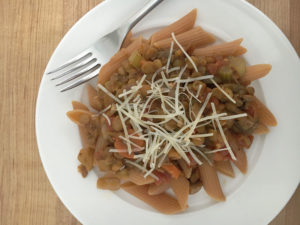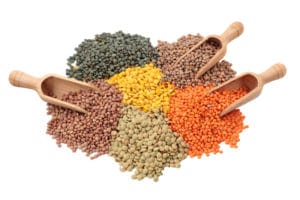By Anne Palumbo
 A small but mighty member of the legume family, lentils have so much going for them it’s hard to know where to begin. Nutritionally dense and loaded with wide-ranging health benefits, lentils are considered by many to be a “superfood.”
A small but mighty member of the legume family, lentils have so much going for them it’s hard to know where to begin. Nutritionally dense and loaded with wide-ranging health benefits, lentils are considered by many to be a “superfood.”
Lentils are remarkable high in fiber — both soluble and insoluble — with one cooked cup providing around 16 grams of this cholesterol-lowering nutrient.
According to the American Heart Association, the average American adult needs about 25 grams of fiber a day to reap its benefits. On average, however, American adults eat only 10 to 15 grams of fiber a day.
Why bump up your fiber intake?
Multiple studies have confirmed that eating lots of fiber can reduce your risk of dying from heart disease, cancer, stroke, and Type 2 diabetes.
Lentils’ impressive amounts of folate and magnesium also contribute to heart health. Folate helps lower levels of homocysteine, an amino acid that when elevated can lead to hardening of the arteries and blood clots, while magnesium helps maintain a steady heartbeat and normal blood pressure. Heart benefits notwithstanding, folate is critical for preventing neural tube defects in newborns.
 Seeking to increase your intake of plant-based protein? Look to lentils, the bean that delivers the second most protein per cup (soybeans take top honors): a whopping 18 grams.
Seeking to increase your intake of plant-based protein? Look to lentils, the bean that delivers the second most protein per cup (soybeans take top honors): a whopping 18 grams.
A building block of bones, muscles and skin, this powerhouse nutrient can also be a dieter’s best friend, as its slower digestion helps to curb snacking, and its metabolic boost (protein takes the most energy to digest) can be a bona fide calorie-burner.
Similar to other beans, lentils are packed with antioxidants — those magical compounds that can help prevent a host of age-related maladies, from heart disease to cancer to Alzheimer’s. Lentils’ antioxidants do a body good by helping to reduce inflammation, lower blood pressure and fight free radical damage.
A versatile bean that cooks in a jiff, lentils are naturally low in fat, sodium, cholesterol and calories: only 230 per cooked cup.
This ancient legume — nearly 10,000 years old — is also a good source of manganese, phosphorous and iron.
Lentil Bolognese
Adapted from Cuisineathome.com
2 tablespoons olive oil
2 cups sliced white or cremini mushrooms (or more)
1 cup chopped onion
3 cloves garlic, minced
1 cup each sliced carrot and celery
2 teaspoons Italian seasoning
1/4 teaspoon red pepper flakes
1 tablespoon tomato paste
2-3/4 cups low-sodium broth: vegetable or chicken
1 can diced tomatoes (14.5 oz.)
3/4 cups lentils
1/4 cup 2% milk
1 teaspoon balsamic vinegar
salt and pepper to taste
8 to 10 oz. pasta of choice
shredded Parmesan
Heat oil in a large saucepan or skillet over medium heat. Add the onion and garlic and sauté until onions become soft, about eight minutes. Add the celery, carrots, mushrooms, Italian seasoning, and pepper flakes; gently heat, partially covered until softened, about 10 minutes, stirring occasionally.
Stir in tomato paste; cook two minutes. Add broth, tomatoes, and lentils; simmer, partially covered, until lentils are tender, 45-50 minutes, stirring occasionally.
Meanwhile, cook pasta in a pot of boiling salted water according to package directions; drain.
Stir milk and vinegar into bolognese; season with salt and coarse black pepper. Serve bolognese over pasta; top with Parmesan.
Helpful tips
Store dry lentils in an airtight container in a cool, dry place for up to a year (can be stored longer, but taste may deteriorate). Cooked lentils will last about a week in refrigerator or up to six months in freezer. Canned lentils have a similar nutritional profile to dry lentils, but may be slightly higher in calories and sodium. Check label and be sure to rinse well before using.
Anne Palumbo is a lifestyle columnist, food guru, and seasoned cook, who has perfected the art of preparing nutritious, calorie-conscious dishes. She is hungry for your questions and comments about SmartBites, so be in touch with Anne at avpalumbo@aol.com.

